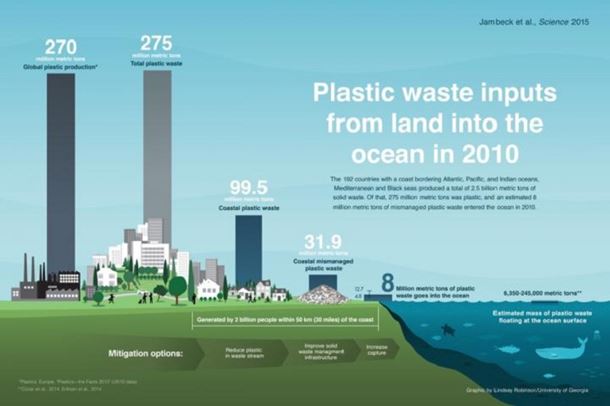 The 192 countries with a coast bordering the Atlanta, Pacific and Indian oceans, Mediterranean and Black seas produced a total of 2.5 billion metric tons of solid waste. Of that, 275 million metric tons was plastic, and an estimated 8 million metric tons of mismanaged plastic waste entered the ocean in 2010. Credit: Lindsay Robinson/University of Georgia.
The 192 countries with a coast bordering the Atlanta, Pacific and Indian oceans, Mediterranean and Black seas produced a total of 2.5 billion metric tons of solid waste. Of that, 275 million metric tons was plastic, and an estimated 8 million metric tons of mismanaged plastic waste entered the ocean in 2010. Credit: Lindsay Robinson/University of Georgia.We finally have a good idea of the amount of plastic waste generated on land that ends up in the world’s oceans. Researchers in the US have developed a model for all sources of plastic that move from our estuaries, seashores and uncontrolled landfills into the ocean, calculating the magnitude at 8 million metric tons (MT) every year.
The study, by Jenna Jambeck from the University of Georgia with colleagues at the National Center for Ecological Analysis and Synthesis, comprising oceanographers, marine ecologists, solid waste experts, statisticians, industrial ecologists, polymer scientists and engineers, provided a global estimate using country-level data from the 192 coastal countries that contribute to this enormous amount of discarded everyday plastic items, such as bags, food wrappers and beverage bottles.
“Eight million metric tons is the equivalent to finding five grocery bags full of plastic on every foot of coastline in the 192 countries we examined”Jenna Jambeck
As reported in Science [Jambeck et al. Science (2015) DOI: 10.1126/science.1260352], their model showed that between 4.8 and 12.7 million metric tons of plastic entered the ocean in 2010 from people living within 50 kilometers of a coastline in those countries. This was out of a total of 275 million MT of plastic waste generated in that year. As Jambeck points out, “Eight million metric tons is the equivalent to finding five grocery bags full of plastic on every foot of coastline in the 192 countries we examined”.
The team linked worldwide data on solid waste, population density and economic status to estimate the mass of land-based plastic waste entering the ocean. The main factors for which countries contributed the greatest mass were population size and the quality of waste management systems. In 2013, the production of plastic resin, used to manufacture many such plastic items, reached 299 million MT globally, a 647% increase over 1975. Previous studies tended to identify the amount of waste floating on the surface, so this research shows how much is being missed, that there must be an excessive amount of plastic on the ocean floor and on beaches around the world.
It is expected to get worse: assuming continuing population growth, increasing plastic consumption and waste generation, the cumulative plastic waste entering the ocean from land could increase cumulatively to 155 million MT by 2025. Solutions involve reducing plastic waste generation and expanding the amount captured and managed properly. The team is now carrying out a global materials flow for plastic, and also looking at other ocean-based sources of input to provide greater insight into the problem.